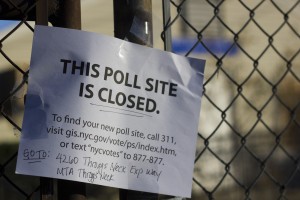Superstorm Sandy made its presence known on Nov. 6, as voters in the presidential election throughout New York City scrambled to find alternative polling sites to replace the ones damaged by the storm.
Sandy caused 60 total changes in voting locations across the five boroughs. Three of those changes took place in the Bronx. The Locust Point polling site moved from the Locust Point Civic Association to the parking lot of the MTA Throgs Neck complex.
Soundview residents voted at the I.S. 174 Eugene T. Maleska School instead of P.S. 69 Journey Prep School, and Riverdale voters went to the Hebrew Institute of Riverdale, which served as a substitute for Draddy Hall at Manhattan College.
Though some people in the affected areas may not have been aware of last minute changes, most voters said they were notified with time to spare.
Riverdale residents relied on the Internet to get updates on site changes. Those without online access were left in the dark.
“On the news they’re telling you to go to a website to check your polling site, but what if you don’t have Internet?” said Irene Bernstein, 63, of Riverdale.
Bernstein expressed concern for the elderly, who she said may not use computers or may have lost Internet access in the storm.
“The elderly are going to be disenfranchised,” Bernstein said.
Several voters from outside the Bronx cast their ballots in the college polling site, making use of Gov. Andrew Cuomo’s executive order to let New Yorkers vote anywhere in the state.
In Locust Point, a quiet, picturesque neighborhood in the southeast Bronx, voting seemed to take place without any hitches.
A makeshift white tent was set up off the Throgs Neck Expressway on Monday evening. Voting machines were brought in Tuesday morning.
Despite the quick turnaround, Locust Point residents said they were notified of the change in good time by the Civic Association and the Board of Elections. They received emails, letters, Facebook notifications and information from local newspapers.

In addition to flyers and email notifications, residents found the new polling sites posted on the the Civic Association gate on Locust Point. (YI DU/The Bronx Ink)
“This was not an inconvenience at all,” said Debbie Suarino of Locust Point.
Suarino’s basement was flooded with three feet of water during the storm, but she made sure to vote. She got her polling site updates from the Civic Association and the New York Daily News.
Louis Bevilacqua, who lives across the street from the Civic Association building, was hit with almost six feet of water. He made it to the voting tent, but said he was focusing more on getting through the aftermath of the storm than the election.
“Was it a top priority? If I missed out on it, I would not have cried,” said Bevilacqua.
For Daniel Tyx, a senior at SUNY Maritime, the storm may have actually made his voting experience easier. Tyx, who is originally from Buffalo, would have had to vote absentee or in Buffalo if not for Cuomo’s executive order.
He said he logged into Google to find the new polling place and had to ask for directions to find it, but understood the difficult circumstances.

A last-minute white tent served as the polling site for Locust Point residents. (YI DU/The Bronx Ink)
“With the given situation, it was more of the best they could do,” Tyx said.
Ruth Desplant, 52, of Soundview, learned about the changes in voting locations from flyers posted on storefronts, on gate entrances and slipped under residents’ doors. Desplant was constantly checking the Board of Elections website on Monday until it crashed later that evening.
Along with her neighbors in a 2-block radius on Underhill Avenue, Desplant did not have electricity for a week after the storm hit. She woke up on Monday morning with the lights inside her home turned on.
Desplant waited for her husband and 19-year old son to finish voting after she cast her own ballot at I.S. 174 Eugene T. Maleska School on White Plains Road. Desplant made sure to inform her son, a first-time voter, about the candidates’ positions in the months leading up to Election Day.
“I explained the ballots to him and that he has to be aware because this will affect him for years to come,” said Desplant. “You can’t complain if you don’t vote.”



